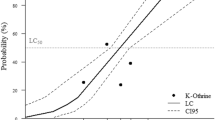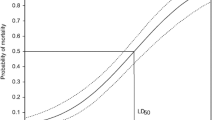Abstract
Neurotoxicant compounds interfere with the behaviour and biology of insects, significantly altering their locomotion patterns. However, little is known about the effect of organophosphates, neurotoxicants for agricultural, domestic and industrial use, on the larval movement of necrophagous flies, although being responsible for frequent cases of poisoning and accidental or intentional deaths. Thus, we aimed to study the influence of Terbufos (organophosphate) on the activity and mobility patterns of Lucilia eximia (Wiedemann 1819) (Calliphoridae) and Peckia (Peckia) chrysostoma (Wiedemann 1830) (Sarcophagidae) immatures collected from rat carcasses intoxicated with 5, 10 or 20 mg/kg of Terbufos, to evaluate (i) peristaltic movements and body contractions, and (ii) distance and shape of the trajectory travelled by the larva. Behavioural parameters were analysed in loco and through videos. We observed that the presence of Terbufos altered poisoned larvae’s activity and body mobility in both taxon and dose-dependent manner. Lucilia eximia larvae were more active, with greater frequency of body movements and lateral contractions when intoxicated with high and intermediate doses of Terbufos. On the other hand, P. (P.) chrysostoma immatures were less active, with fewer body and lateral contractions when intoxicated with the high dose of the compound. This work experimentally demonstrates that the presence of Terbufos can alters the mobility and movement of intoxicated necrophagous Diptera, essential components of the cadaveric fauna.





Similar content being viewed by others
References
Alpino TMA, Santos CRB, Barros DC, Freitas CM (2020) COVID-19 and food and nutritional (in)security: action by the Brazilian Federal Government during the pandemic, with budget cuts and institutional dismantlement. Cad Saúde Pub 36(8):e00161320. https://doi.org/10.1590/0102-311X00161320
Andrade JB, Rocha FA, Rodrigues P, Rosa GS, Faria LDB, Von Zuben CJ et al (2002) Larval dispersal and predation in experimental populations of Chrysomya albiceps and Cochliomyia macellaria (Diptera: Calliphoridae). Mem Inst Oswaldo Cruz 97:1137–1140
Arnott S, Turner B (2008) Post-feeding larval behaviour in the blowfly, Calliphora vicina: Effects on post-mortem interval estimates. Forensic Sci Int 177:162–167
Barbosa TM, Jales JT, Medeiros JR, Vasconcelos SD, Gama RA (2021) Behavioural aspects of the prey-predator interaction among necrophagous Diptera: Implications for cadaveric colonization. Neotrop Entomol 50:303–311. https://doi.org/10.1007/s13744-020-00837-z
Bariola LA (1984) Pink bollworms (Lepidoptera: Gelechiidae): effects of low concentrations of selected insecticides on mating and fecundity in the laboratory. J Econ Entomol 77:1278–1282
Berrigan D, Pepin DJ (1995) How larvae move: allometry and kinematics of crawling in larval Diptera. J Insect Physiol 41:329–337
Carmo RFR, Oliveira DL, Barbosa TM, Soares TF, Souza JRB, Vasconcelos SD (2017) Visitors versus colonizers: an empirical study on the use of vertebrate carcasses by necrophagous Diptera in a Rainforest fragment. Ann Entomol Soc Am 110:492–500
Carvalho CJB, Mello-Patiu CA (2008) Key to the adults of the most common forensic species of Diptera in South America. Rev Bras Entomol 52:390–406
Carvalho LML, Linhares AX, Trigo JR (2001) Determination of drug levels and effect of Diazepam on the growth of necrophagous flies of forensic importance in southeastern Brazil. Forensic Sci Int 120:140–144
Catts EP, Goff M (1992) Forensic entomology in criminal investigations. Ann Rev Entomol 37:253–272
Charabidze D, Bourela B, Leblanc H, Hedouin V, Gosseta D (2008) Effect of body length and temperature on the crawling speed of Protophormia terranovae larvae (Robineau-Desvoidy) (Diptera: Calliphoridae). J Ins Physiol 54:529–533
Chophi R, Sharma S, Sharma S, Singh R (2019) Forensic entomotoxicology: Current concepts, trends and challenges. J Forensic and Legal Med 67:28–36. https://doi.org/10.1016/j.jflm.2019.07.010.91
Čičková H, Newton GL, Lacy RC, Kozánek M (2015) The use of fly larvae for organic waste treatment. Waste Manag 35:68–80. https://doi.org/10.1016/j.wasman.2014.09.026
da Silva EIT, Wilhelmi B, Villet MH (2017) Forensic entomotoxicology revisited towards professional standardisation of study designs. Int J Legal Med 131(5):1399–1412. https://doi.org/10.1007/s00414-017-1603-9
de França SM, Breda MO, Barbosa DRS, Araujo AMN, Guedes CA (2017) The sublethal effects of insecticides in insects. Chapter 2 from Shields, Vonnie DC (2017). Bio Control of Pest and Vector Ins. https://doi.org/10.5772/66461
Desneux N, Decourtye A, Delpuech JM (2007) The sublethal effects of pesticides on beneficial arthropods. Ann Rev Entomol 52(1):81–106. https://doi.org/10.1146/annurev.ento.52.110405.091440
Eddleston M (2019) Organophosphorus insecticide self-poisoning. Ann Rev Pharmacol and Toxicol 59:341–360
Environmental Protection Agency (EPA) (2013) Recognition and management of pesticide poisonings, 6th edn. Washington, DC. http://www2.epa.gov/pesticide-workersafety
Godoy WAC, Fowler HG, Zuben CJL, Ziti L, Ribeiro OB (1995) Larval dispersion in Chrysomya megacephala, Chrysomya putoria and Cochliomyia macellaria (Dipt., Calliphoridae). J Applied Entomol 119:263–266
Goff ML, Lord WD (1994) Entomotoxicology: a new area for forensic investigation. Am J Forensic Med and Pathol 15:51–57
Gosselin M, Wille SMR, Fernandez MDMR, Di Fazio V, Samyn N, Boeck GD, Bourel B (2011) Entomotoxicology, experimental set-up and interpretation for forensic. Toxicologists. Forensic Sci Int 208(1-3):1–9. https://doi.org/10.1016/j.forsciint.2010.12.015
Hamilton RL, Schal C (1990) Sublethal effects of chlorpyrifos-methyl on reproduction in female German cockroaches (Dictyoptera: Blattellidae). J Eco Entomol 83(44):1–443
Haynes KF (1988) Sublethal effects of neurotoxic insecticides on insect behavior. Ann Rev Entomol 33(1):149–168. https://doi.org/10.1146/annurev.en.33.010188.00105392
Hoy JB, Dahlsten DL (1984) Effects of malathion and Staley’s bail on the behavior and survival of parasitic Hymenoptera. Environmental Entomol 13:483–486
Hunter PE, Cutkomp LK, Kolkaila AM (1958) Reproduction in DDT- and diazinontreated house flies. J Economic Entomol 5l:579–582
Introna F, Campobasso CP, Goff ML (2001) Entomotoxicology. Forensic Sci Int 15,120(1-2):42–47. https://doi.org/10.1016/s0379-0738(01)00418-2
Jales JT, Barbosa TM, Santos LC, Rachettii VPS, Gama RA (2020) Carrion decomposition and assemblage of necrophagous dipterans associated with Terbufos (Organophosphate) intoxicated rat carcasses. Acta Tropica 212:105652
Jales JT, Barbosa TM, Soares VP, Gama RA (2021) Effect of Terbufos (Organophosphate) on the cadaveric colonization process: implications for post-mortem interval calculation. J Med Entomol 58(3):1056–1063. https://doi.org/10.1093/jme/tjaa284
Jayaraj R, Megha P, Sreedev P (2016) Organochlorine pesticides, their toxic effects on living organisms and their fate in the environment. Interdisciplinary Toxicol 9(3-4):90–100. https://doi.org/10.1515/intox-2016-0012
Kaushal J, Khatri M, Arya SK (2021) A treatise on Organophosphate pesticide pollution: Current strategies and advancements in their environmental degradation and elimination. Ecotoxicol and Environmental Safety 207:111483. https://doi.org/10.1016/j.ecoenv.2020.111483
Lee CY (2000) Sublethal effects of insecticides on longevity, fecundity and behaviour of insect pests: a review. J of Bioscience 11:107–112
Malloy CA, Somasundaram E, Omar A, Bhutto U, Medley M, Dzubuka N et al (2019) Pharmacological identification of cholinergic receptor subtypes: modulation of locomotion and neural circuit excitability in Drosophila larvae. Neuroscience 411:47–64
Meira LMR, Barbosa TM, Jales JT, Santos AN, Gama RA (2020) Insects associated to crime scenes in the northeast of Brazil: consolidation of collaboration between entomologists and criminal investigation institutes. J Med Entomol 57(4):1012–1020. https://doi.org/10.1093/jme/tjaa040
Nichols CD, Pandey UB (2012) Methods to assay Drosophila behavior. J Visualized Experiments 61:e3795
Oliveira-Costa J (2003) Insetos peritos: a entomologia Forense no Brasil. Millennium, Campinas-SP, p 257
Reigada C, Godoy WAC (2005) Dispersal and predation behavior in larvae of Chrysomya albiceps and Chrysomya megacephala (Diptera: Calliphoridae). J Insect Behavior 18:543–555
Robinson LA, Bryson D, Bulling MT, Sparks N, Wellard KS (2018) Post-feeding activity of Lucilia sericata (Diptera: Calliphoridae) on common domestic indoor surfaces and its effect on development. F Sci Int 286:177–184
Sidhu GK, Singh S, Kumar V, Dhanjal DS, Datta S, Singh J (2019) Toxicity, monitoring and biodegradation of organophosphate pesticides: a review. Critical Reviews in Env Sci and Technol 49(13):1135–1187. https://doi.org/10.1080/10643389.2019.1565554
Siegfried BD, Scharf ME (2001) Mechanisms of organophosphate resistance in insects. Biochemical sites of insecticide action and resistance. Springer-Verlag, Berlin, Heidelberg
Silva JCS et al (2016) Factors associated with the deaths of men poisoned by carbamato (“chumbinho”). Rev Gaucha Enferm 37(2):e54799. https://doi.org/10.1590/1983-1447.2016.02.54799
Schricker B, Stephen WP (1970) The effect of sublethal doses of Parathion on honeybee behaviour. I. Oral administration and the communication dance. J Apicultural Research 9(3):141–153. https://doi.org/10.1080/00218839.1970.11100261
Singh D, Bala M (2010) Studies on larval dispersal in two species of blow flies (Diptera: Calliphoridae). J Forensic Res 1:1–3. https://doi.org/10.4172/2157-7145.1000102
Tracqui A, Keyser-Tracqui C, Kintz P, Ludes B (2004) Entomotoxicology for the forensic toxicologist: much ado about nothing? Int J of Legal Med 118(4):194–196. https://doi.org/10.1007/s00414-004-0442-7
US Environmental Protection Agency (EPA) (2006) US Environmental Protection Agency Office of pesticide programs reregistration eligibility decision for Terbufós 2006
Von Zuben CJ, Bassanezi RC, dos Reis SF, Godoy WAC, Von Zuben FJ (1996) Theoretical approaches to forensic entomology: 1. Mathematical model of postfeeding larval dispersal. J Appl Entomol 120:379–382
Funding
None.
Author information
Authors and Affiliations
Contributions
Jéssica Teixeira Jales: conceptualization, methodology, investigation, resources, writing original draft, writing review and editing; Taciano de Moura Barbosa: conceptualization, investigation, validation, formal analysis, writing original draft, writing review and editing; Victor Ramon Firmo Moreira: methodology, investigation; Simão Dias Vasconcelos: writing original draft, visualization, supervision; Vanessa de Paula Soares Rachetti: writing original draft, visualization, supervision; Renata Antonaci Gama: conceptualization, writing original draft, project administration.
Corresponding author
Ethics declarations
Competing Interests
The author Simão Dias Vasconcelos is part of the editorial board of this journal, so it is important to indicate the possible conflicts of interest here.
Additional information
Edited by Patrícia J Thyssen
Publisher’s Note
Springer Nature remains neutral with regard to jurisdictional claims in published maps and institutional affiliations.
Supplementary information
Lucilia eximia control larvae (not intoxicated). Perceive standard peristaltic body contractions, with the movement of the head piece left and right during the process. (MP4 17351 kb)
Lucilia eximia larvae intoxicated with high dose of Terbufos. Perceive incoordination of body contractions and great larval agitation. (MP4 11394 kb)
Peckia (P.) chrysostoma control larvae (not intoxicated). Coordinated movements of body contraction and movement of the head piece guiding the trajectory. (MP4 10562 kb)
Peckia (P.) chrysostoma larvae intoxicated with high dose of Terbufos, noticing slower larvae during the movement process and the presence of body spasms. (MP4 10592 kb)
Rights and permissions
Springer Nature or its licensor (e.g. a society or other partner) holds exclusive rights to this article under a publishing agreement with the author(s) or other rightsholder(s); author self-archiving of the accepted manuscript version of this article is solely governed by the terms of such publishing agreement and applicable law.
About this article
Cite this article
Jales, J.T., Barbosa, T.M., Moreira, V.R.F. et al. Effects of Terbufos (Organophosphate) on Larval Behaviour of Two Forensically Important Diptera Species: Contributions for Entomotoxicology. Neotrop Entomol 52, 1155–1164 (2023). https://doi.org/10.1007/s13744-023-01094-6
Received:
Accepted:
Published:
Issue Date:
DOI: https://doi.org/10.1007/s13744-023-01094-6




